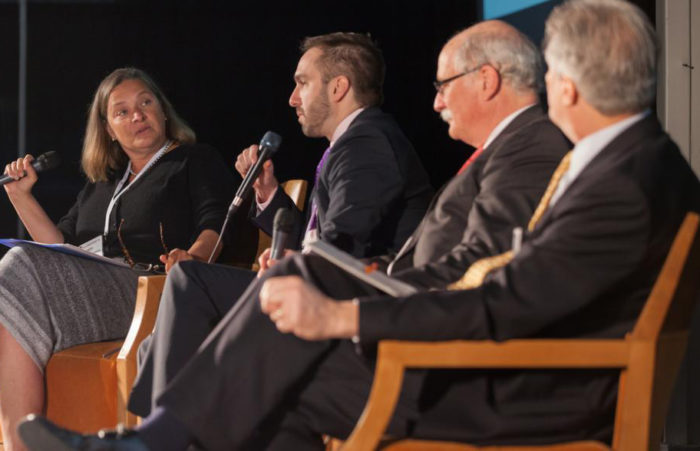
Image Credit: NESEA
For 36 years, my professional community has been the Northeast Sustainable Energy Association (NESEA). In early March we gathered once again in Boston for the BuildingEnergy conference. It was one of the best ever.
I go to BuildingEnergy to get my mind twisted out of my ordinary fixed ideas and to learn new ways to think. This year was a bumper crop.
Beyond footprints to handprints
I took a half-day workshop with Greg Norris. Norris is an expert in Life Cycle Assessment (LCA), which seeks to quantify the energy, water, and other impacts that are embodied in materials and products. He recently become chief scientist at the International Living Futures Institute.The Institute’s first initiative was the Living Building Challenge, but it is now also focusing on products and neighborhoods.
In this workshop on nontoxic materials, Norris presented the most inspiring thing I heard at the entire conference: the concept of handprinting. The premise is that everything we buy or consume has a footprint, and even a vegan bike-riding solar-powered person dressed in second-hand clothes has a footprint — there’s no such thing as a zero footprint.
In other words, a footprint represents what we take. But we can act positively as well — a simple example is planting a tree — and those actions can be analyzed with the same analytic tools in many cases to tally up the give as well as the take of ourselves and our organizations.
Handprinting combined with footprinting leads to the concept of NetPositive: giving more than we take. I found it to be a liberating construct. One exciting aspect is that the definition of what constitutes a handprint vs. a reduced footprint is yet to be fully defined in relation to buildings. When we design and build a net-zero building, is the baseline the code building, or is it no building? Big difference! Thanks to Greg for doing this work!
For more information, see Building NetPositive Enterprises and Handprint: A New Unit for Measuring Impact.
More on footprints
The concepts of footprinting and lice-cycle assessment were embedded into the conference. At the company where I work, South Mountain Company, we’ve been footprinting our operations — office and shop and jobsite energy, employee transportation, materials transportation. The most obvious conclusion has been that employee transportation on the Island is the largest portion by far, and we’ve recently re-aligned our benefits and incentives to promote higher efficiency transportation, chiefly electric vehicles.
Byggmeister (the company founded by Paul Eldrenkamp) and South Mountain Company presented a session on our beginner’s steps on this stuff, and Byggmeister’s work focused beyond ours to include the embodied energy in the materials they put into place. We’re starting a similar effort in analyzing a couple of the affordable houses we’ve built. Detailed stuff, would make even a bookkeeper’s brain trip out on overload!
We are dematerializing
Howard Brown of dMass and Mark Loeffler of Atelier 10 spoke about the dematerialization of our economy. Brown was a student of Buckminster Fuller and reminds us that people want benefits not products, and every effort to deliver the benefits with less mass gets closer to the proposition of naked value, and has lower environmental impact.
As Howard succinctly says, benefits are weightless. What was inspiring was the number of items they showed that were in development last year that are on the market this year. Brown emphasizes that it’s increasingly common that breakthroughs are being made by people without specialized training but rather a determination to find a better way to do something.
Examples of cool stuff:
- Piezoelectric tiles in high traffic areas like subway stations to generate electricity
- Ecovative is adding to its base business of producing packing material from ag waste and fungal mycelium by making structural biocomposites to replace materials like OSB.
- Concrete cloth: rolls of cloth impregnated with cement; dampen and it sets up.
- Building-integrated wastewater hydropower in high-rise buildings, and power from pressure-reducing valves in water supply pipelines.
- Active ceramic anti-bacterial tiles.
Old farts and young superstars
The closing forum had three old farts, I mean, friends, and three young superstars, each doing 20 slides in the pecha kucha technique. It was a rousing and inspiring finish to a great gathering: old guys John Abrams, Terry Brennan, and Chuck Silver, with the young-uns Stephanie Horowitz, Ace McArleton, and Declan Keefe showing us the way to the future.
I got to meet past and new students from my Zero Net Energy Homes Online Course. And I saw hundreds of friends and colleagues, all gathered to vision a better future, and share wholeheartedly our collective experience on how to get there. If you missed BuildingEnergy this year, well, like the Sox, there’s always next year.
Marc Rosenbaum is director of engineering at South Mountain Company on the island of Martha’s Vineyard in Massachusetts. He writes a blog called Thriving on Low Carbon. Marc teaches a 10-week online Zero Net Energy Home Design course as part of NESEA’s Building Energy Master Series. You can test drive his class for free.
Weekly Newsletter
Get building science and energy efficiency advice, plus special offers, in your inbox.















0 Comments
Log in or create an account to post a comment.
Sign up Log in